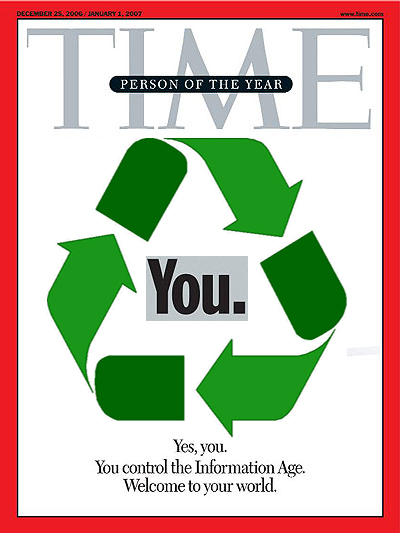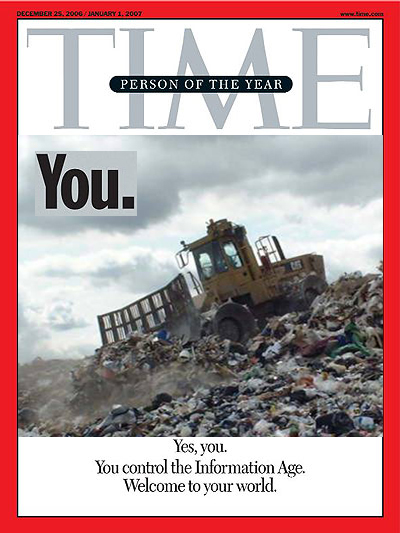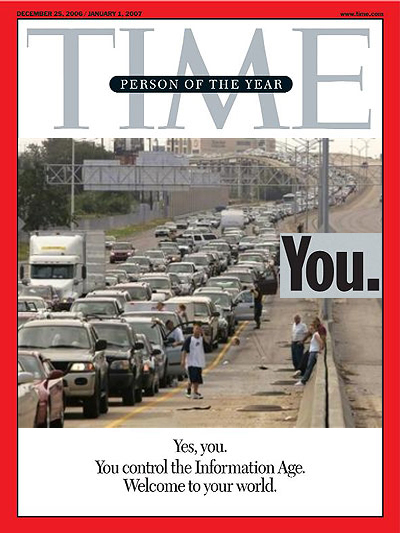
In the middle of December 2006, Time Magazine released its annual Person of the Year issue and stirred up a small media frenzy by proclaiming this year’s winner to be the somewhat eponymous “you”. The idea behind this proclamation is the supposed influence of the accumulated efforts of the “little people” against the might of concentrated power. Thanks, Time, for yet another sentimental ode to the “little people”. This media-constructed humunculus – “you” – has, according to this particular arm of the Time-Warner media empire, taken power away from the corporate and media elite by means of YouTube and Wikipedia, open-source software and user-produced media, and Web 2.0 and cellphone cameras. What a magical and revolutionary time in which we live, when technology is available to liberate the individual.
Well, please forgive this “little person” writer from Hamilton for questioning the wisdom of the Time-Warner empire trumpeting the technological utopia which awaits, but Pardon My Lunch Bucket.
Ok, just so the cards are on the table here: one of the largest media conglomerates in the world is telling us that through the collective will of our user-produced efforts, the power dynamic is switching from elite control to mass, democratic control of the mediasphere. Finally, after years of neglect by the media hierarchy, suddenly the voices of the mass citizen are being heard. The will of the people is now more accurately realized. Democracy 2.0, if you like. But of course, we won’t know the full story of this revolution unless money is exchanged so that a certain media conglomeration will release to the masses this knowledge in the form of a paid-subscription magazine. Which sounds suspiciously like that old democracy that we already have, and which for the vast majority of the working population amounts to Democracy 0.7 (beta).

So what? you might ask, they’re just trying to sell magazines. And here we come to the point. Time-Warner sells roughly 5 million monthly copies of Time Magazine in North America. It is not unreasonable to assume that an end-of-year special issue sold around the holiday season has the potential to double those sales figures. All told, production of this magazine amounts to roughly 200,000 tonnes of waste and consumes roughly 1,000,000 trees per year. You might assume in an era of blue-box programs that Time-Warner could use recycled paper to print, instead of cutting down virgin forests. In 1994, they did indeed move to a 10% recycled-paper mandate, but changed that stance less than a year later.
To make the issue even more obsessive, I am not so sure that the metallic foil used to create the mirror on the cover of the 2006 “You” issue of Time Magazine is the most recyclable thing. I would guess quite the opposite in fact, and thus the whole issue would end up in the trash in the face of the economic reality of recycling, namely who sorts the shit. Furthermore, we can talk about the environmental impact of the energy spent producing and distributing the magazine. Long story made brief, by purchasing this issue, “you” are indeed making waves in the world. To summarize: this corporation cuts down forests and contributes to climate change to sell us a product describing how we the “little people” are affecting positive change in the world.
2006 was for many the year of environmental awareness. After the surge in environmental “events” over the past three or four years, the media could no longer ignore the science of climate change. Leaders of the world’s nations are now almost universal in their call to address the issue. In the wake of a poll suggesting that 70% of Canadians think the environment to be one of the most important issues for the country, the notoriously anti-green Conservative government has done an about-face and reinstituted the Liberal government’s previous environmental policies that it had scrapped the year before (read: no new money, in real terms).
In light of the urgency of the matter (as of January 21, 2007, I would like to welcome most people who live in southern Ontario to the beginning of only our second week of “proper” winter temperatures) I think that Time Magazine’s rather empty gesture can be easily co-opted into something of greater significance. This indeed is the time in which “you” is a needed concept in relation to societal change, but not in the superficial manner suggested by Time .
Conceptually speaking, Time’s notion of the power and influence of “you” is misguided at best, and self-serving and delusional at worst. If Time Magazine were serious about its conception of this all-important “you”, then it would have printed a magazine containing user-produced content of the type it is glamourizing. A whole issue created by the readers. Or it might have put a different image on its cover, such as what I have here produced in five seconds.

An even more interesting discussion would be about the true power of this “you” in relation to social change. Along the lines of, say, the Orange Revolution in the Ukraine a few years ago. Remember that little “you” event, when millions of Ukrainians participated in daily protests and general strikes until the leaders who stole power gave up control of the government to properly elected officials?
Such efforts might prove useful in dealing with the fact that 70% of the American population wants the Iraq war to end at the same time that the White House is requesting the commitment of additional troops. Follow that example of “you” from eastern Europe: stop going to work, stop going to school, stop going to the mall, stop everything until the war stops. Then when the war stops, put an “American” spin on the event by going back to work and fighting for health-care. Surely, Time could mobilize its wide readership to act for change by talking about this revolutionary “you” power in a more legitimate sense than they have. But then again, in the process Time-Warner would probably lose a great deal of ad revenue, among other things.
And yet the Time article was not wholly wrong. The technologies to which it refers in judging the importance of “you” are indeed progressive technologies. But the important thing about YouTube is not that more and more people are making videos about politics using Lego parts. It’s that people are realizing that they would rather spend hours and hours making said Lego masterpieces than sit and watch network television or otherwise participate in the traditional mediasphere.
I am well aware as to the reasons why a legitimate debate concerning the true impact of “you” on human civilization and the Earth as a whole will not happen in a publication such as Time Magazine. That discussion might begin by investigating the degree to which journalism has fallen from its once important function as arbiter for the public good.
Don’t listen to the media elites as to why this change occurred toward the end of the last century; they’ll tell you that they are simply providing that which “you” are demanding. After all, it was “you” that brought to television American Idol and to the internet the execution of Saddam Hussein. So it will be “you” that programs the next revolution: a people with revolutionary potential are reduced to staring into the cover of a magazine in a supermarket, trying to find themselves.
2 comments:
Hello Quintin Hewlett,
My name is Will Brown, I'm contacting you from Adbusters magazine based in Vancouver, Canada. We've been reviewing our submissions for our upcoming issue and we'd like to run your Time magazine cover with the traffic jam in our Letters section in the upcoming May/June issue of the magazine. Is it possible to submit a high res publication quality version of the image? Our deadline is March 15th, will be on the newsstands on April 17th. Let me know!
Thanks,
Will
time_cars2.jpg
_______________________________________
Adbusters Magazine
1243 West 7th Avenue, Vancouver, BC. V6H 1B7
p: 604.736.9401 f: 604.737.6021
http://www.adbusters.org
artdirector@adbusters.org
i only have a low-res version available, as the images derive from web sources and are formatted for web display. ;-(
q x
Post a Comment